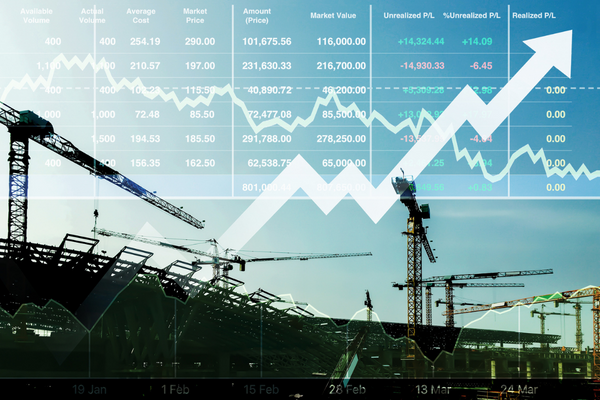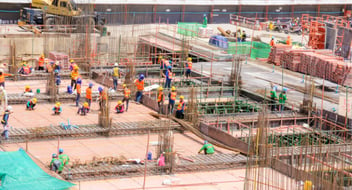
The construction industry is massive. The McKinsey Global Institute (MGI) puts global construction-related spending at $10 trillion, equivalent to 13% of global GDP. Yet the profit margins in the industry, according to MGI, are in the bottom quartile compared with other sectors.
Many experts say to realize greater profits, construction firms need to increase digitization.
Lagging Productivity Linked to Lack of Digitization
You would think an industry as large and powerful as construction would be willing to embrace construction technology—just as they would the latest and greatest heavy machinery or tools of the trade. However, the industry’s reputation for reluctance to digital change is well earned.
According to MGI, global labor productivity in the construction industry has grown an average of just 1% annually over the last two decades, compared with 3.6% for manufacturing and 2.8% for the entire global economy. If productivity in the industry were equal to that of the overall economy, $1.6 trillion a year could be added in value, according to MGI calculations.
So, why is the industry experiencing lagging levels of productivity? Many point to a lack of digitization (the process of converting from analog to digital processes) as a significant reason for this underperformance.
While some construction companies have embraced everything construction technology and digital tools have to offer, others are still dependent on old-school tools. It’s clear the pace of digitalization varies greatly across the industry. Even within firms, investment in and use of technology can be unequal among different groups, such as with estimators or project managers.
A global survey from KPMG found that just 16% of executives say their organizations have fully integrated systems and tools. Even fewer (6%) say that all or most of their business processes are automated. On the flip side, a few respondents said their organizations are not integrated and don’t plan to do so.
Overall, the industry is moving toward digitization. While the transformation has been happening slowly, the pandemic and its impact on the work environment nudged companies forward. More and more companies now recognize how digitization improves project management and leads to increased profits.
How Digitization Improves Communication
Any successful construction project requires that everyone move in the same direction. The more the team is on the same page (preferably from bid to buildout), the better the entire construction project will flow.
Ever play the game “telephone”? Some may know it as “whisper down the lane.” One person whispers a few sentences or a string of words to the person next to them. The second person whispers what they heard to a third person and so on, until a several people have heard and in turn whispered what they heard to the next person.
Once the person at the end of the line hears the sentences, they say what they heard out loud for everyone to hear. The group usually erupts in laughter because what the last person says is completely different from what the first person said.
Without digitized information, a construction project can turn into a game of whisper down the lane: information is miscommunicated. One person understands a direction in one way, and another person understands it differently. This leads to mistakes, delays, and increased costs.
Digitization improves communication and efficiency. For example, when you use a Common Data Environment, you can rely on a single source of truth. With information digitally stored, everyone on the team has access to the latest designs and documents, reducing misunderstandings.
A KPMG survey found that digital leaders are 12% more operationally efficient than their competitors. Efficiency starts with communication.
When everyone on the team is on the same page with digital tools helping them get there, issues can be hashed out more quickly. Ultimately, project delivery will proceed more smoothly, leading to reduced timelines, fewer delays, and reduced risk.
Strategic Decision-Making Starts with Correct Data
Like any other business, a typical construction project involves many stakeholders within the same firm—with some using siloed tools that don’t integrate.
Owners and operators making strategic decisions need a global picture of their projects to guide the company forward. Yet information is often fragmented, leading to decisions that include as much intuition and guesswork as analysis.
Departments within a construction company need to emerge from their silos. Consider when you’re putting together a bid for a capital project. How much should you bid to ensure you don’t bid too low or too high?
Determining the bid requires pulling numbers and information from multiple departments. It requires a review of similar jobs completed in the past, consideration of the available workforce (if additional craft workers are needed), a study of material prices, etc. There are a lot of moving parts.
For example, an estimator may assume that labor is the base wage plus 26%. But if they double-check with the accounting department, they may realize their real true labor cost.
Dodge notes that 66% of construction owners say digital workflows frequently result in better-informed decision-making on projects.
In addition, having information digitized and stored so it is easily reviewed can lead to enhanced insights. Your team can gather for a post-mortem meeting and study why a project met or failed to meet profitability goals to determine what needs to be done differently.
In the end, digitization leads to improved strategic decision-making, which can have a huge impact on profits.
Making the Most of Your Resources
For many owners and operators, profits are razor thin. Maximizing profits requires you to optimize resources—both the physical labor as well as materials and supplies.
The labor squeeze is nothing new. The construction industry has been suffering from a shortage of employees for years. Much of the construction workforce is aging (50% over age 45) and under-skilled. Developing the workforce by offering digitization tools and skills to make workers more technologically savvy would boost productivity and profitability.
The labor shortage is not just regional. Deloitte has explored this global labor shortage, explaining that many thought the shortage would fade as the pandemic receded. But we’re still waiting.
Material shortages persist as well. The supply chain has become unreliable, making construction projects drag on, and the workforce unable to move on to new projects. This wastes time and minimizes profitability. Digitization can offer more insight into the supply chain and ultimately enable more control over resource management.
Using data, you can gain insights into the supply chain to adapt and adjust. Your project team can reorganize and reschedule a project or stages within a project. This improves productivity and profitability.
MGI research found that action in seven areas can boost productivity by 50% to 60%. Those areas include reskilling workers, improving procurement, and alleviating supply chain issues.
Digitization helps construction companies make the most of their resources. This is critically important, particularly in these challenging times.
Construction companies must fully embrace digitization to maximize profits. Digitization can help any construction firm and the industry as a whole.
Ready to boost your bottom line by adopting digital? Find out how Asite can help you achieve just that. Learn more here.
Larry Bernstein
Larry is a New Jersey-based writer who specializes in construction and construction technology.
4 minute read
Asite Insights in your inbox.
Sign up for product news and our latest insights published monthly. It's a newsletter so hot, even global warming can't keep up.






